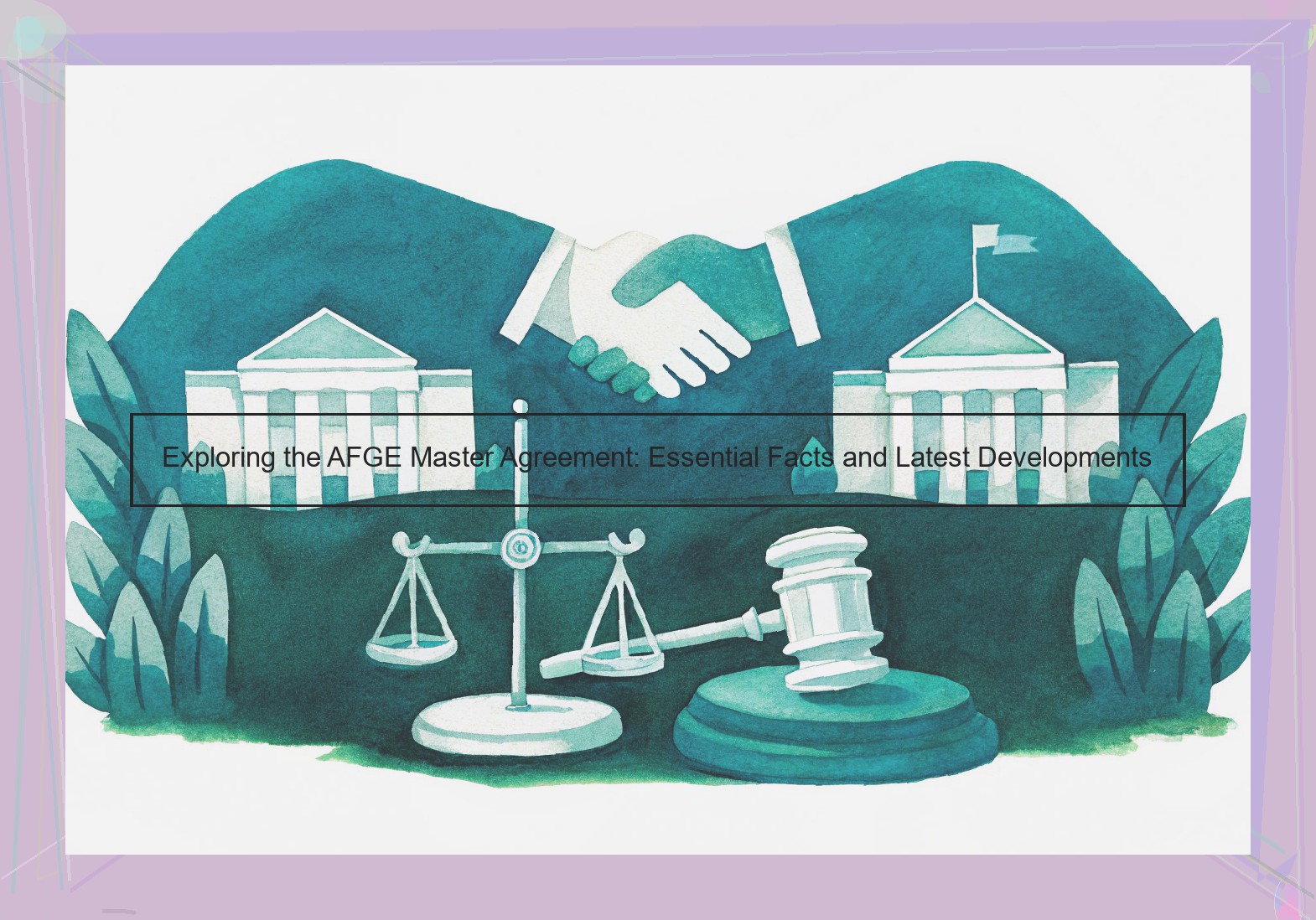The AFGE Master Agreement Explained
Each bargaining unit of the American Federation of Government Employees ("AFGE") has adopted a "master agreement" to work to achieved its overall purpose of "directly addressing the concerns and well-being of our members, while increasing the efficiency of our government." The AFGE will make updates to the master agreement via negotiations on a regular basis. The last such substantial update occurred in 2016, when the AFGE and the Office of Personnel Management ("OPM") negotiated a comprehensive new Master Labor Agreement covering all employees represented by the national union. This national agreement, which took effect September 13, 2016, replaces all 33 previous agency-specific master agreements negotiated by the AFGE.
The Master Labor Agreement contains provisions governing almost every aspect of the relationship between the government and the federal employee. It is authorized by federal law, specifically Title 5 of the U.S. Code , Chapter 71, § 7114, which provides that "An exclusive representative of an appropriate unit in an agency may be given an opportunity to be represented at any formal discussion at which the employee is present and which will result in the personnel policy or practices or other general conditions of employment affecting the general employee group."
For AFGE members, the Master Agreement is the contract between the employee and the federal government. Its effectiveness is validated by the fact that any violation of its terms can be grieved and eventually arbitrated.
Over the years, the Master Agreement and subsequent AFGE/OPM negotiations has sought to prevent actions which will "chill" the incentives of federal employees to present grievances or seek redress. As the negotiations have progressed over the past decades, one overarching goal has been to prevent the situation where an employee will be punished for filing a grievance.
Important Aspects of the Agreement
The following are some of the key provisions of the AFGE Master Agreement:
Grievance Procedure
One of the most important cornerstones of the Fair Labor Standards Act of 1978 is the grievance procedure. This is a contractual provision which sets forth the process for resolving disputes (known as "grievances") between employees and Agency management. A grievance is defined very broadly as:
(1) any claimed violation of the law, regulation, directive, order, or practice concerning the employee’s working conditions, job and physical job requirements, and other job related concerns . . .
and violations of employee rights or the rules of the Agency for general health and safety or individual rights. This includes but is not limited to:
(a) Conditions related to workplace air quality, noise, and temperature;
(b) Harassment in the workplace;
(c) Job stress, such as injuries brought on by excessive overtime;
(d) Working overtime because the employer failed to hire sufficient numbers for proper staffing;
(e) Denial of employee assistance to exercise statutory rights; and
(f) Any unsatisfactory work performance evaluations which are unrelated to actual work performance . . .
The grievance procedure is both a right and a protection. It gives Agency employees a system by which they can pursue and enforce their rights, and it protects against unfair treatment by Agency management that seeks to retaliate against an employee or to deprive him or her of a right or benefit. Stated differently, the grievance procedure protects both the procedural and substantive rights of Agency employees.
Collective Bargaining Agreement (CBA)
The Collective Bargaining Agreement (CBA) creates a dispute resolution system for grievances concerning the interpretation or application of provisions of the Agreement. The Agency and the Union have jointly agreed to a three-step grievance process to be used in resolving any problems that arise while administering the Agreement. Under the CBA, a grievance may be initiated by the Local Union President on an individual behalf or by any employee or group of employees (known as the "Grievant") for violations of the labor agreement, except for matters described in Article 5, Section 3.
The entire grievance process usually lasts around 44 workdays and is divided into the following three steps:
Employees can only file a grievance against the Agency for contract violations. If an employee is experiencing workplace issues with their supervisors or coworkers, based on the CBA, these matters must be resolved informally between the involved parties. After three attempts, if an agreement cannot be reached, the involved parties may proceed with the grievance procedure.
However, the CBA does not provide the same for disputes or resolutions that occur outside any formal collective bargaining agreements. For example, if an employee is experiencing sexual harassment or hostile work environment, there are other administrative channels to explore.
With the CBA grievance procedure, it is easy to assume that a written grievance may be filed by employees. However, this is not true. Employees or groups of employees who wish to file a grievance against a contractual violation must first contact the representative in their local area. Such representatives include Shop Stewards, Union Delegates, and Executive Board members for the Local Union. These union representatives then issue the written grievance based on the demands of the employees.
Should You Hire a Lawyer?
Agencies sometimes limit grievance activity because there may exist, for instance, an established policy that prohibits employee time used for grievance activity that does not involve pay. Once contact is lost, the case can become difficult to resolve, reverting to an administrative grievance investigation. In many circumstances, you will be required to seek resolution from your Agency’s designated Federally Employed Women’s Program Coordinator (FEWP) or the Equal Employment Opportunity Office (EEO).
Very often, it is wise to seek legal representation before proceeding with a grievance. Attorneys practicing federal labor law can help hold your agency accountable by identifying the contractual provisions involved, and filling in the gaps with appropriate case law. They can also help you respond to further resistance from your agency, such as reprimands and retaliation.
AFGE Action Bargaining
The role of the American Federation of Government Employees in the negotiation of the terms and conditions of the Master Agreement cannot be understated. The AFGE negotiates on behalf of thousands of bargaining unit employees to secure what they believe are the terms and conditions of employment that will create an environment of prosperity for their members. The negotiation of these provisions can be contentious and often requires the assistance of a neutral party such as an FMCS Commissioner or a third-party arbitrator.
The AFGE has been instrumental in pushing for certain provisions during the negotiations with the Treasury. During the 2000-2001 negotiations, the AFGE succeeded in having the new provisions established under the Fair Labor Standards Act (FLSA) incorporated into the Master Agreement as new Articles 46, 47, and 48 of the AMT Master Agreement. These provisions dictate how FLSA work and hours are to be processed, and employees must consult them to see if they are eligible and entitled to FLSA overtime to make sure they receive the compensation they earned and are entitled to.
Negotiations with the AFGE occur at regular intervals, every three years. The AFGE bargaining team understands the necessity to thoroughly consider, negotiate, and finalize the Master Agreement. It is also important to keep the members informed and educated about the provisions of the Master Agreement. The Sharing Success Plan (SSP) was one way the AFGE attempted to keep the membership involved in the negotiating process when conducting meetings either in person and or by conference calls, and collecting bargaining unit data and ideas for the bargaining process.
Members of the AFGE are often most familiar with the contents of the Master Agreement, and who to ask if they have questions or need additional information. AFGE representatives can provide guidance to employees who have specific concerns about the content of the agreement, and they can often direct them to resources who can give the members further advice or guidance.
Effects on Federal Workers
The AFGE federal master agreement has far-reaching effects for the federal employees covered by it. First, it covers employees of over 50 federal agencies, making almost every federal employee a union member. As such, it touches on issues of benefits, pay, and working conditions.
Pay raises: The AFGE Master Agreement mandates an annual pay raise to be included in collective bargaining agreements. This raise is often higher than the standard cost of living adjustments. AFGE members are more likely to see a pay raise than non-unionized workers.
Mediations and grievances: When a grievance is filed, the AFGE negotiation team is responsible for mediating the situation. This includes everything from a one-on-one meeting to more comprehensive negotiations with the agency regarding workplace conditions. Often just the recourse to the union is enough to quell a workplace problem . If a grievance does go to court, the Union pays for legal representation, whereas employees would have otherwise had to represent themselves.
Strong workplace standards: Public employees are subject to some of the highest workplace standards in the country, and for good reason. For Federal employees, the AFGE helped to create these standards and protect them in negotiations. These standards are guaranteed under law for union members and are therefore more difficult for those members’ employers to violate.
Strong job security: Federal employees have some of the strongest job protections in the country. Under AFGE, members are afforded certain protections if their contracts are terminated, and the union can not be dismissed without just cause. In some cases, represented employees are less expensive to employ than non-represented ones due to pay negotiations, raises and benefits. This is one reason why AFGE has recently begun to expand its reach into private sector unions.
Recent Developments and Revisions
In order to stay current with the constantly evolving federal sector environment, AFGE continues to update its Master Agreement. Recent updates have focused on addressing the ever-expanding use of technology and telework in the federal sector and addressing the needs and desires of management and the personnel it employs. Major revisions to the AFGE Master Agreement most recently came in 2016 with a two-year term that is set to expire in 2018. Significant changes made to the Master Agreement include a change to the way overtime is calculated, revised merit promotion language, increased telework opportunities, additional language covering alternative work schedules, and increase pay for alternative work schedules. AFGE is currently negotiating a new Master Agreement with the Department of Homeland Security that is set to expire in 2019.
Accessing the Agreement
A simplified, searchable version of the AFGE Master Agreement is publicly available online. The Agreement may be accessed by visiting the FEDSMILL website. FEDSMILL provides searchable content, both individually and collectively, to the AFGE Master Agreement and the Federal Labor Relations Authority’s Regulations.
Employers, union representatives, and interested employees should consult the explanation of how to search the FEDSMILL database to help facilitate familiarity with searching the database. Notably, the search engine provides access to the entire AFGE publication. It lays out the collective bargaining agreement’s terms of employment on the basis of paragraph and subsection numbers that correspond to those in the publication. No other numbering system can change the search results for any provision in the publication . However, the publication does not provide a subject or topic index. A person must know the location of a specific provision to conduct a search.
Additionally, workplace parties may visit the American Federation of Government Employees (AFGE)’s website to access the AFGE Master Agreement. The website provides both an Adobe Reader and a Word document version of the publication.
Companies and union leadership professionals should note that the Agreement is enforceable under the same statutes, rules, and regulations governing all federal sector labor-management relations. Specifically, this includes the Fair Labor Standards Act, as administered by Wage and Hour Division Enforcement Office Managers and Labor Relations Specialists, under 5 CFR Parts 551, 553, and 554.


